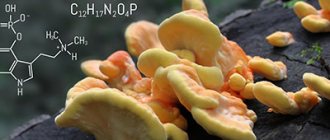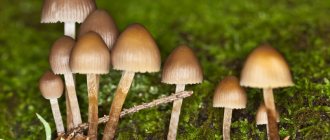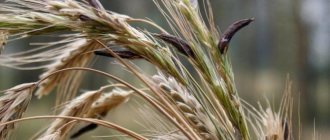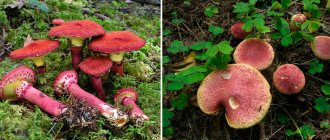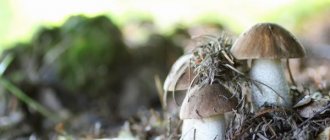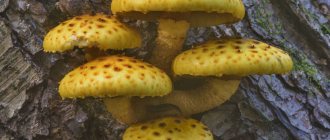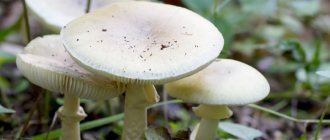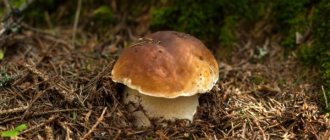Hallucinogenic mushrooms (“magic mushrooms”, “hallucinogenic mushrooms, hallucinogenic mushrooms”, magic magic mushrooms) are all names for a group of mushrooms that contain psychoactive substances that cause narcotic (psychedelic) sensations. They are usually eaten for narcotic purposes or as a result of mistaken identity. Currently, about 80 species of mushrooms with hallucinogenic properties are known. Hallucinogenic mushrooms belong mainly to the psilocybe genus Psilocybe (psilocybin mushrooms), and sometimes to Gymnopilus and Panaeolus. There are about 140 species in the world, of which about 80 are classified as hallucinogens. They grow on almost every continent, but most types of magic mushrooms grow in Mexico.
Content:
- Types of mushrooms and methods of consumption
- Effect of a hallucinogen on the body 2.1. Effects of short-term use 2.2. Effect with prolonged use
- Consequences of taking mushroom drugs
- Treatment of mushroom addiction
Today, about 190 species of narcotic mushrooms are known. They grow on different continents and climatic zones, they can even be cultivated at home. Due to its accessibility, the use of this natural intoxicating product has become a new dangerous hobby among young people, teenagers, and in creative environments.
Hallucinogenic mushrooms are affectionately called magic or magic mushrooms among fans of this cheap high because of the colorful and unusual visions that arise when consuming them. Many are confident that natural origin is a guarantee of the safety and harmlessness of the substance. But in the case of mushrooms, this is not at all the case, since consumption of the hallucinogen causes addiction, psychological dependence and disorders of the central nervous system.
Historical information[ edit | edit code]
Since ancient times, humanity has known the psychotropic properties of some mushrooms, for which there is a lot of archaeological evidence. Magical properties were attributed to such mushrooms [3] [4] [5] and they were used in religious rituals.
The oldest rock paintings of rituals in which psychoactive mushrooms were used are known in Africa and are 6,500–9,000 years old. Such drawings are known in Algeria (Tassilin-Ajjer), Libya (Tadrart-Akakus mountains), Chad (Ennedi plateau), Egypt (Jebel Ounat, en: Jebel Uweinat) [4] [5].
In India (Kerala state, near the village of Chermanangad) there are megaliths in the form of mushrooms over 3000 years old, which are called kudakallu
- “umbrella stones” [4].
In the Rig Veda, about a thousand hymns are dedicated to the sacred intoxicating drink “soma,” which, according to R. G. Wasson (1968) [6], was prepared from red fly agaric mushrooms. The ancient Indians believed that soma helps maintain health, prolongs life, and the person who drinks the drink merges with the deity. However, the connection between soma and kudakallu
is not clear; these structures were erected during the era of the Dravidian civilization that existed in India before the arrival of the Aryans.
In early Christian and medieval churches of Tunisia and Western Europe, frescoes were discovered depicting “mushroom trees” entwined with snakes, which indicates [source?] the presence of the cult of mushrooms in early Christian traditions [4] [7]. Psychotropic mushrooms (wheat grains infected with ergot) were allegedly used in ancient Greece in the ceremonies of the Eleusinian mysteries [4] [5].
The use of psychogenic mushrooms was widespread among the Indians of pre-Columbian Mexico and Central America. Thus, the red fly agaric was a sacred mushroom among the ancient Mayans [7] [8], and psilocybe was already used in religious rituals by the Aztecs 3000 years ago [5]. The Aztecs called these mushrooms " teonanacatl"
” - “the body of god”, and only the chosen and initiated used it [9]. Temples more than 2,500 years old with sculptures of a magic mushroom with a human face have been discovered in Guatemala [5]. Rituals using hallucinogenic mushrooms have been preserved among Central American tribes until the present day [10] [11].
Types of mushrooms and methods of consumption
The most common are representatives of the genus Psilocybe and Conocybe, native to South America, Mexico, Malaysia, and Indonesia. The active ingredients psilocybin and psilocin they contain provide vivid visions and euphoria.
The amount of these compounds depends on the type of fungus and averages 0.1-0.6% of the dry mass. Narcotic components, entering the body, affect the metabolic processes of the neurotransmitter serotonin in the brain, which are responsible for critical thinking and behavior, regulation of emotions and information processing.
In our latitudes you can also find mushrooms with an intoxicating effect:
- red, royal, toadstool and panther fly agaric;
- paneolus moth;
- fibre, sharp;
- Psilocybe semilanceolata and Montana;
- woodpecker and hay dung beetle.
I would like to say a few words regarding fly agarics. When prepared differently, they have different effects. Red fly agarics are the least dangerous, causing sensations similar to alcohol intoxication. But brindles often lead to death, no matter how you prepare them.
An inexperienced mushroom picker who does not know what dangerous mushrooms look like can easily confuse them with edible ones. Therefore, on a quiet hunt, if the slightest doubt arises, it is better to leave the gifts of the forest in the same clearing where they were found.
To obtain the desired effect, mushrooms are used fresh or dried. They are chewed, brewed, and even mixed with other products. A special feature of this drug is that it does not lose its properties when dried and heat treated. Therefore, it can be prepared for future use or added to dishes to overcome the bitter taste of psilocycin.
Many people practice growing narcotic mushrooms in their garden plots. This requires minimal knowledge and the creation of certain conditions: humidity, air temperature, fertilizing. It should only be taken into account that the deliberate collection and use of mushrooms with a narcotic effect is prohibited by the legislation of the Russian Federation and many other countries.
Map photo
Mushrooms in the Leningrad region 2022 go looking and, focusing on the general map, where the following are highlighted:
- Priozersky district;
- Sosnovo with its mixed forests;
- Losevo, where not far from Vuoksa moss mushrooms, a lot of boletus mushrooms, a lot of porcini mushrooms and oil caps sprout;
- Volkhovsky district, rich in chanterelles, boletuses, rich in porcini mushrooms (go to Chernoushevo, Kiselnoye, Kolchanovo village);
- Vyborgsky district, where hot spots are concentrated near Lake Zerkalnoe or near the village of Ryabovo;
- the Karelian Isthmus, pleasantly surprising with the variety of noble mushrooms;
- forest areas near Myllyupelto (no further than Pochinok, Motorny or Solnechny), where it is most convenient to get to by your own car;
- Podporozhsky district, where the village of Verkhniye Mandrogi remains the most popular among experienced mushroom pickers;
- Lodeynopolsky district, where people go for porcini mushrooms, boletus mushrooms, and boletuses mainly in the direction of the village of Alekhovshchina;
- Luzhsky district, not further than the village of Serebryansky.
The effect of a hallucinogen on the body
The first doses are usually tried for company or out of curiosity, but sometimes the expected effect does not occur. The person may feel nauseous, overexcited, and afraid. It is very difficult to predict the effect of mushrooms during trial consumption, since it depends on the individual characteristics of the psyche and emotional state.
Effects of short-term use
In a small dose (6-10 mg), the drug causes relaxation after 15-20 minutes, a feeling of euphoria, bright and fabulous visions.
The duration of such sensations ranges from 30 minutes to 6 hours. At this moment, drug addicts perceive the world around them in a distorted form, hallucinations take on vivid forms and unusual sounds. The main manifestations are as follows:
- a good mood;
- causeless joy and laughter;
- altered perception, such as slow or distorted sensations;
- photosensitivity;
- dilated pupils;
- itching and weakness in the limbs;
- increased blood pressure and heart rate;
- frequent breathing.
Often, someone who has consumed dangerous mushrooms loses control over their movements and is unable to distinguish real events from a colorful illusion.
Effect with prolonged use
If psilocybin mushrooms are taken for a long time or in large quantities, psychosis or a panic attack may develop, since the psycho-emotional sphere is primarily at risk of complications. In this case, the following are observed:
- memory problems;
- decreased mental abilities;
- weakening of the level of motivation;
- overexcitement;
- panic and delirium.
Even after giving up a hallucinogenic substance, so-called flashbacks make themselves felt months or even years later. These are optical illusory visions and sound hallucinations that occur without stimulating influence.
Places of distribution
- Distributed throughout the world, mainly in temperate and subarctic latitudes.
- Psilocybe mushrooms grow from August until the first frosts and snowfalls.
Many people wonder where to look for psilocybin mushrooms? In the Moscow region, for example, they can be found among the grass in a meadow or pasture; they prefer a humid environment, so they can grow near streams, and can be found in irrigated areas: on the lawn of a park or even a stadium. They grow in groups; if at least one is found, it means that many more mushrooms can be found nearby.
Consequences of taking mushroom drugs
This herbal stimulant does not cause physical dependence, but a strong attachment is formed at the psychological level. If you take it more than once a week, addiction develops, in which to achieve the desired pleasure you need to almost double the one-time serving.
The systematic effect of psilocybin on the serotonin centers of the brain leads to their gradual degradation. In this case, a pathological condition similar to schizophrenia develops. Drug addicts who eat mushrooms become indifferent and lethargic, losing interest in their previous hobbies.
Very often they are characterized by the so-called “philosophical intoxication,” which is characterized by long and incoherent discussions on topics of religion, creativity, and medicine. This behavior complicates communication with friends, family members, and co-workers, which causes misunderstandings, disagreements, and alienation of the addict.
For drug addicts, mushrooms are a strong neurotoxic poison, under the influence of which psychoses and neuroses, schizophrenia, psychopathic disorders, and genetic disorders develop. Subconscious fears, complexes and insecurities that people try to hide in everyday life come out in a relaxed consciousness. And this is forever a positive moment, because a person becomes very suggestible and doubts everything in the world.
Even if hallucinogenic substances do not contribute to the formation of physical cravings, they can provoke injuries, accidents, and injuries due to psycho-emotional instability and behavioral abnormalities. It is very difficult to predict the actions of a person in a state of “mushroom” high. Unpredictable aggression can lead to suicide attempts and crimes.
The use of narcotic mushrooms by women during pregnancy significantly increases the likelihood of miscarriage, premature birth, and placental abruption. A newborn baby is often diagnosed with birth defects, low body weight, and psychological problems as they grow up.
Overdose
The main danger is the development of an overdose or a reaction of individual intolerance. They are manifested by the following symptoms:
- diplopia - double vision
- tachycardia or, conversely, a sharp decrease in heart rate
- arterial hyper- or hypotension
- increase in body temperature
- salivation and lacrimation
- behavioral inhibition
- amazing chills
- diarrhea
- nausea
- impairment of motor and speech coordination
- vomit
- pain in the stomach and head
- drowsiness
- disturbance of consciousness - stupor, stupor, coma
The worst outcome is acute psychosis with severe hallucinations and complete loss of awareness. In this state, a person is dangerous to himself and the people around him.
Deaths from heart failure, acute kidney injury, or respiratory arrest are extremely rare.
Treatment of mushroom addiction
If you or a loved one is unable to cope with an addiction to a plant hallucinogenic drug, then it is better to contact specialists at a drug treatment clinic. After a thorough history and examination, the doctor will develop an individual treatment program.
To optimize treatment measures, it is important what mushrooms drug addicts eat in order to determine the necessary methods of intoxication. The narcologist will take into account the experience and intensity of taking the hallucinogen, the gender and age of the patient, his physical and psycho-emotional indicators.
Complete treatment consists of several stages:
- Medical examination. After interviewing and examining the patient, the doctor prescribes, if necessary, additional hardware diagnostics and laboratory tests. Determines the stage of addiction and the presence of chronic and concomitant illnesses.
- Detoxification activities. Various methods are designed to remove toxins and poisons from the body in order to minimize their negative effects and normalize impaired functions.
- Drug therapy. Pharmacological drugs and dosage are selected individually in accordance with the diagnosed diseases and abnormalities.
- Psychotherapeutic sessions. Individual and group classes, hypnosis, and self-analysis can not only motivate the patient to heal, but also stabilize the mental state and normalize the emotional background.
- Additional procedures. Massage and physiotherapy help the patient to relax, restore general well-being and get ready to overcome the illness.
- Rehabilitation period. This is the final stage of the treatment plan, which forms the prototype of the patient’s new life without a hallucinogen, and allows for the restoration of lost friendly, family and social connections.
If you are familiar with the information about which mushrooms are narcotic and what danger their use poses to humans, then it will be easier for you to resist the temptation. And you will know what to do if you need qualified help - go to a drug treatment center.
Weakly hallucinogenic Paneolus moth
Another herbaceous-dung resident, Paneolus moth, is also a bit similar to the fun-loving one. Most often it can be found in grassy areas with cow or horse manure. Young mushrooms have gray-brown conical caps, slightly curved inward, with scaly remains of the cover. With age, they take on the shape of a bell, lighten, and almost all the scales fall off. The length of the leg can reach 12 cm, it is very brittle, hollow, dirty brown in color, which becomes darker when pressed. In small mushrooms, the stem is covered with a white coating, but in adults it is not. The grayish pulp is thin, odorless.
According to some sources, psilocybin is contained in a small concentration in the pulp of this mushroom, but it still causes hallucinations, albeit an order of magnitude weaker.
Literature:
- Vishnevsky, Mikhail Vladimirovich. Inedible poisonous and hallucinogenic mushrooms: Reference-atlas / M. V. Vishnevsky. – M.: Formica-S, 2001. – 190, [2] p.
- Psilocybin-containing mushrooms [Text]: (criminologist and forensic medical research) / [Babakhanyan R.V., Bushuev E.S., Kazankov S.P., etc.]; St. Petersburg state honey. University named after acad. I. P. Pavlova and others - St. Petersburg: St. Petersburg State Medical University, 1998. - 107 p.
- Current problems of the drug situation among young people: status, trends, prevention: [monograph] / [author. : Sheregi F. E. et al.] ; Ministry of Education and Science of Russia. Federation, Center of Sociol. research – M.: Center for Social Sciences. forecasting, 2004. – 499, [1] p.
- Drugs: properties, action, pharmacokinetics, metabolism: textbook / N. V. Veselovskaya [etc.]. – 3rd ed., revised, corrected. and additional – Moscow: Narconet, 2008. – 262 p. : ill., table.
Fun mushroom
Among the lamellar mushrooms of the strophariaceae family there are miniature and slender mushrooms called Psilocybe semilunate. They grow mainly in grass, among abandoned farms, where the soil is fertilized with animal manure. The diameter of the conical cap does not exceed 25 mm, but its height is one and a half times greater. The skin is slimy and peels off easily; it is beige in color; in old mushrooms it is brown. A humid growing environment promotes the appearance of darker stripes on the cap. The leg is quite tall and thin, but very flexible, slightly lighter than the hat. The yellowish pulp turns blue when broken (and also when dried).
Psilocybe semilanceolata is also called the fungus for its hallucinogenic properties. Other names for the mushroom: sharp conical bald head, liberty cap.
The psychoactive substances contained in mushrooms have an almost irreparable effect on the nervous system and psyche. 10-20 minutes after consuming the decoction with mushrooms, consciousness begins to change, peace sets in, turning into depression and possible loss of mind. The effect of mushrooms lasts up to 7 hours, but the enhanced perception of the surrounding world persists for several more days.
Bright beauty stropharia blue-green
Among the rotten wood of spruce species, a small, beautiful, brightly colored mushroom grows in small groups - blue-green stropharia. Young specimens have a conical cap that is dark blue with a green tint and is completely covered with thick mucus. A darker hill can be seen in the center, and white flakes hang from the edges - the remains of the bedspread. Old mushrooms are no longer so slimy and less colorful. The leg is the same color as the cap, scaly at the bottom and ringed at the top. When cut, the cap is bluish and the leg is yellow, the flesh smells pleasant. The total height of the mushroom does not exceed 10 cm.
In most countries, blue-green stropharia is considered an edible mushroom and is eaten after first removing the skin and boiling it well. However, its pulp contains meconic acid, which is part of opium, and in raw or undercooked form, the mushrooms cause mild hallucinations, however, the effect disappears after two hours.
Photogenic Gymnopilus Juno
In mid-summer, under the oak trees, whole families of fairly large mushrooms with orange fleshy caps on dense legs in a brown belt grow. This is Gymnopilus Juno and its yellowish, very bitter and almond-smelling pulp contains psilocybin. After dinner with such mushrooms, you can admire visual hallucinations for several hours.
The amount of psychedelics in the pulp of Gymnopilus depends on the area of growth: the most hallucinogenic are mushrooms growing in the countries of the Far East, but European species can be completely harmless.

